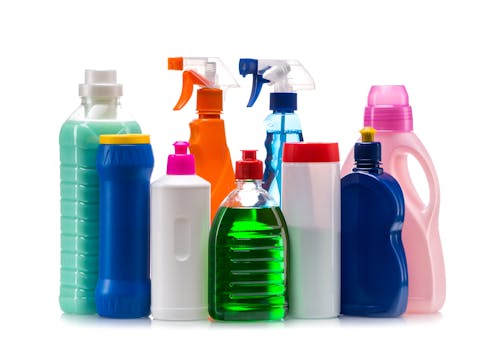Body lotions, mothballs, cleaning fluids and other widely used products contain known toxic chemicals, study finds
- Written by Robin Dodson, Adjunct Assistant Professor of Environmental Health, Boston University

The Research Brief[1] is a short take about interesting academic work.
The big idea
Consumer products released more than 5,000 tons of chemicals in 2020 inside California homes and workplaces that are known to cause cancer, adversely affect sexual function and fertility in adults or harm developing fetuses, according to our newly published study[2].
We found that many household products like shampoos, body lotions, cleaners and mothballs release toxic volatile organic compounds, or VOCs, into indoor air. In addition, we identified toxic VOCs that are prevalent in products heavily used by workers on the job, such as cleaning fluids, adhesives, paint removers and nail polish. However, gaps in laws that govern ingredient disclosure mean that neither consumers nor workers generally know what is in the products they use.
For this study we analyzed data from the California Air Resources Board[3] (CARB), which tracks VOCs released from consumer products in an effort to reduce smog. The agency periodically surveys companies that sell products in California, collecting information on concentrations of VOCs used in everything from hair spray to windshield wiper fluid.
We cross-referenced the most recent data with a list of chemicals identified as carcinogens or reproductive/developmental toxicants under California’s right-to-know law, Proposition 65[4]. This measure, enacted in 1986, requires businesses to notify Californians about significant exposure to chemicals that are known to cause cancer, birth defects or other reproductive harms.
We found 33 toxic VOCs present in consumer products. Over 100 consumer products covered by the CARB contain VOCs listed under Prop 65.
Of these, we identified 30 product types and 11 chemicals that we see as high priorities for either reformulation with safer alternatives or regulatory action because of the chemicals’ high toxicity and widespread use.
Why it matters
Our study identifies consumer products containing carcinogens and reproductive and developmental toxicants that are widely used at home and in the workplace. Consumers have limited information about these products’ ingredients.
We also found that people are likely co-exposed to many hazardous chemicals together as mixtures through use of many different products, which often contain many chemicals of health concern. For example, janitors might use a combination of general cleaners, degreasers, detergents and other maintenance products. This could expose them to more than 20 different Prop 65-listed VOCs.
Similarly, people experience aggregate exposures to the same chemical from multiple sources. Methanol, which is listed under Prop 65 for developmental toxicity, was found in 58 product categories. Diethanolamine, a chemical frequently used in products like shampoos that are creamy or foamy, appeared in 40 different product categories. Canada and the European Union prohibit its use in cosmetics[5] because it can react with other ingredients to form chemicals that may cause cancer.
Some chemicals, such as N-methyl-2-pyrrolidone and ethylene gylcol, are listed under Prop 65 because they are reproductive or developmental toxicants. Yet they appeared widely in goods such as personal care products, cleansers and art supplies that are routinely used by children or people who are pregnant.
Our findings could help state and federal agencies strengthen chemical regulations. We identified five chemicals – cumene, 1,3-dichloropropene, diethanolamine, ethylene oxide and styrene – as high-priority targets for risk evaluation and management under the Toxic Substances Control Act[6] by the U.S. Environmental Protection Agency.
What still isn’t known
Our analysis of the CARB data on volatile toxicants does not paint a complete picture. Many toxic chemicals, such as lead, PFAS and bisphenol A (BPA), don’t have to be reported to the Air Resources Board because they are not volatile, meaning that they don’t readily turn from liquid to gas at room temperature.
In addition, we were not able to identify specific products of concern because the agency aggregates data over whole categories of products.
What other research is being done
Studies have shown that women generally use more[8] cosmetic, personal care and cleaning products than men, so they are likely to be more highly exposed to harmful chemicals in these categories. Further, women working in settings like nail salons[9] may be exposed from products used both personally and professionally.
Research by members of our team has also shown that product use varies by race and ethnicity[10], partly due to racialized beauty standards[11]. Policy interventions could be tailored to prioritize these potentially more-highly exposed groups.
Ultimately, a right-to-know law like Prop 65 can only go so far in addressing toxics in products. We’ve found in other research[12] that some manufacturers do choose to reformulate their products to avoid Prop 65 chemicals, rather than having to warn customers about toxic ingredients.
But Prop 65 does not ban or restrict any chemicals, and there is no requirement for manufacturers to choose safer substitutes. We believe our new analysis points to the need for national action that ensures consumers and workers alike have safer products.
Dr. Kristin Knox at the Silent Spring Institute[13] contributed to this article.
References
- ^ Research Brief (theconversation.com)
- ^ our newly published study (doi.org)
- ^ California Air Resources Board (ww2.arb.ca.gov)
- ^ Proposition 65 (oehha.ca.gov)
- ^ prohibit its use in cosmetics (www.nytimes.com)
- ^ Toxic Substances Control Act (www.epa.gov)
- ^ Jeff Greenberg/Universal Images Group via Getty Images (www.gettyimages.com)
- ^ generally use more (doi.org)
- ^ settings like nail salons (theconversation.com)
- ^ product use varies by race and ethnicity (doi.org)
- ^ racialized beauty standards (theconversation.com)
- ^ other research (www.ecologylawquarterly.org)
- ^ Silent Spring Institute (silentspring.org)
Authors: Robin Dodson, Adjunct Assistant Professor of Environmental Health, Boston University


